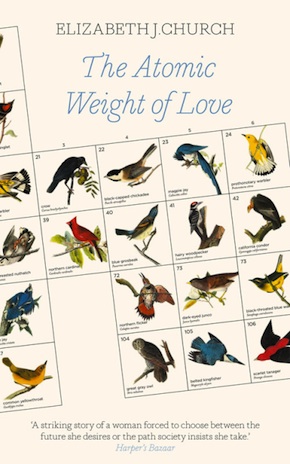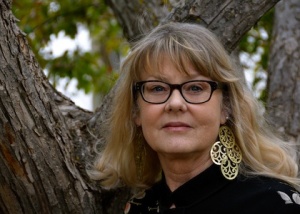Measuring change – and holding onto it
by Elizabeth J. Church
“An elegant glimpse into the evolution of love and womanhood.” Kirkus Reviews
“You’ve come a long way, baby!” Such was the tagline of a US ad campaign launched in 1968 to sell Virginia Slims cigarettes. Images of women portrayed as hip, mod, and independent (all with cigarette in hand), were paired with historical depictions of drudgery and repression. Clearly, Madison Avenue wanted American women to believe they’d made great strides (indeed, such great strides that they had their very own, slimmer cigarette to fit their delicate, feminine hands). But had they truly made it? Or did they still have a long, long way to go?
In my novel The Atomic Weight of Love, I seek to explore the changes American women experienced during the second half of the 20th century. My character Meridian Wallace sets out in the early 1940s to pursue a degree in biology at the University of Chicago. Extremely bright and driven, she readily stands out as the only woman in most of her science courses, and while she is committed to her ultimate dream of obtaining a PhD in ornithology, she encounters numerous hurdles along the way.
Some of the hurdles are cultural; some are other women and their entrenched attitudes. One very large hurdle is Meridian’s husband Alden Whetstone, a physicist who is twenty years her senior. When he is called to work on the Manhattan Project in the secret wartime city of Los Alamos, New Mexico where the first atomic bomb was created, Meridian’s career takes a back seat to both the necessities of war and the societal assumption that she will accede to her husband’s wishes.
Meridian and Alden do not negotiate their relationship; he dictates, as was common then. There is no question that Alden does the driving and Meridian is merely along for the ride. As the breadwinner, Alden controls the money; Meridian is permitted a household allowance. Alden’s palate determines what they’ll have for dinner, and the guest list at any dinner party Meridian might give is decided by her husband. At one point, an emergency-room physician who treats her discusses her condition with Alden, barely addressing Meridian. There is no doubt she faces tough odds in terms of reaching her ornithological goal. Just as with many of us, though, her biggest hurdle may be herself – and the sort of stealthy inertia that grows fat over time.
Meridian’s dream of becoming an ornithologist is a brave one. In the United States in 1940, only 3.8 per cent of people over the age of twenty-five who had earned a college degree were women. In 1968, when the Phillip Morris Company said we’d at last “come a long way” that number had risen minimally, to 8 per cent.
Her spirit is diminished, her hopes fading. And then one day while she’s watching her familiar family of crows, she meets a young man who challenges her and asks her to spread her wings, to take flight”
After the war, Alden declines to live in “some student’s turret” while his wife attends graduate school. He instead opts to remain in Los Alamos, where the newly-formed national laboratory provides him with unprecedented opportunities to pursue his research. Meridian loves her husband and tries to make do, as her father had always advised. Taking careful notes, she observes a community of crows in a nearby canyon. At first she convinces herself that her observations can form the basis of a research thesis, but as the years pass it becomes clear that Meridian will never take up her deferred admission to Cornell. She lets loose the balloon of her dream, and she subsides into banality.
Although American women won the right to vote in 1920, as late as 1942 only twenty-eight states allowed women to serve as jurors. It was not until 1973 that women were permitted to serve on juries in all fifty states. In many states, a woman’s right to hold property in her own name remained limited. With regard to birth control – perhaps the most fundamental means women have of directing and determining the course of their lives – it was not until 1965 that the United States Supreme Court in Griswold v. Connecticut overturned one of the last state laws prohibiting the use of contraceptives by married couples. Roe v. Wade, the decision that confirmed a woman’s right to an abortion during the first trimester of pregnancy, did not come about until 1973 – and remains under attack to this day.
Meridian is understandably flattened beneath the weight of all of this. Her spirit is diminished, her hopes fading. And then one day while she’s watching her familiar family of crows, she meets a young man – a Vietnam War veteran, hippie and geologist – with whom she falls in love. Clay supports Meridian in a way she’s never before been bolstered. Through Clay, she sees how the world is changing. He challenges her, asks her to look at her life, and asks her to spread her wings, to take flight – an act that he rightly describes as a decisive versus passive one. The crux of the novel and of who Meridian decides to become is determined by her reaction to the catalyst that is Clay.
Meridian’s life bears witness to the explosion of recognition of women’s rights in the US. And yet we’ve not reached the finish line. The right to earn a living, to be paid equally for the same work performed by men, remains elusive. Although the Equal Pay Act of 1963 requires that men and women in the same workplace be given equal pay for equal work, the law has not created any genuine guarantees for women. In 2014, for example, the typical American woman working full-time earned only 79 cents for every dollar a man earned. The pay gap is even greater for African-American and Latina women.
Sometimes it’s hard to envision just how much dramatic change was brought about by the Women’s Movement of the last half of the 20th century. Our memories fade, and we take for granted the hard-won victories of our predecessors. Perhaps, too, we lose sight of how easily those rights can be erased. By chronicling the changes through the eyes and life of Meridian Wallace Whetstone, I hope to create a strong reminder that although we have indeed come a long way, we’ve still got some distance to go.
 Elizabeth J. Church was born in Los Alamos, New Mexico. Her father, a research chemist, was drafted out of Carnegie Mellon University, where he was pursuing his graduate studies, and was sent to join other scientists working in secret on the Manhattan Project. Church’s mother, a biologist, eventually joined her husband in Los Alamos. While The Atomic Weight of Love is not their story, it is the story of many women who sacrificed their careers so that their husbands could pursue unique opportunities in scientific research. Her first novel, it is published by Fourth Estate in hardback and eBook. Read more.
Elizabeth J. Church was born in Los Alamos, New Mexico. Her father, a research chemist, was drafted out of Carnegie Mellon University, where he was pursuing his graduate studies, and was sent to join other scientists working in secret on the Manhattan Project. Church’s mother, a biologist, eventually joined her husband in Los Alamos. While The Atomic Weight of Love is not their story, it is the story of many women who sacrificed their careers so that their husbands could pursue unique opportunities in scientific research. Her first novel, it is published by Fourth Estate in hardback and eBook. Read more.
@ElizJChurch
Author portrait © Alan A. Church

